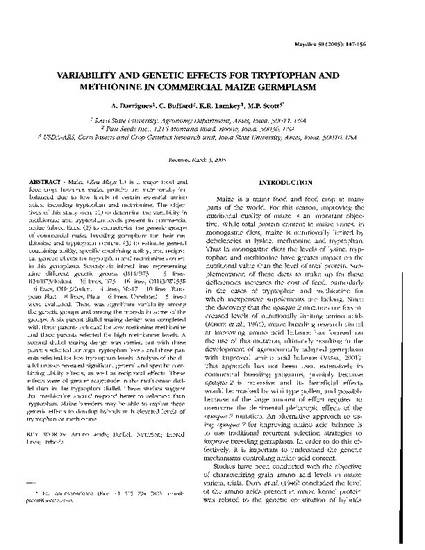
Maize (Zea Mays L.) is a major food and feed crop; however, maize proteins are nutritionally imbalanced due to low levels of certain essential amino acids, including tryptophan and methionine. The objectives of this study were (1) to determine the variability in methionine and tryptophan levels present in commercial maize inbred lines, (2) to characterize the genetic groups of commercial maize breeding germplasm for their methionine and tryptophan content, (3) to estimate general combining ability, specific combining ability, and reciprocal genetic effects for tryptophan and methionine content in this germplasm. Seventy-six inbred lines representing nine different genetic groups (B14/B73 - 5 lines, B14/B73/Iodent - 16 lines, B73 - 16 lines, OH43/W153R - 6 lines, OH43/Iodent - 4 lines, Mo17 - 10 lines, European Flint - 8 lines, Plata - 6 lines, Unrelated - 5 lines) were evaluated .. There was significant variability among the genetic groups and among the inbreds in some of the groups. A six-parent diallel mating design was completed with three parents selected for low metionine methionine and three parents selected for high methionine levels. A second diallel mating design was carried out with three parents selected for high tryptophan levels and three parents selected for low tryptophan levels. Analysis of the diallel crosses revealed significant general and specific combining ability effects, as well as reciprocal effects. These effects were of greater magnitude in the methionine diallei than in the tryptophan diallel. These studies suggest that methionine should respond better to selection than tryptophan. Maize breeders may be able to exploit these genetic effects to develop hybrids with elevated levels of tryptophan or methionine.
Available at: http://works.bepress.com/kendall_lamkey/6/

This article is from Maydica 50 (2005): 147–156. Posted with permission.